check engine MITSUBISHI SHOGUN 2003 Owner's Manual (in English)
[x] Cancel search | Manufacturer: MITSUBISHI, Model Year: 2003, Model line: SHOGUN, Model: MITSUBISHI SHOGUN 2003Pages: 392, PDF Size: 14.34 MB
Page 32 of 392
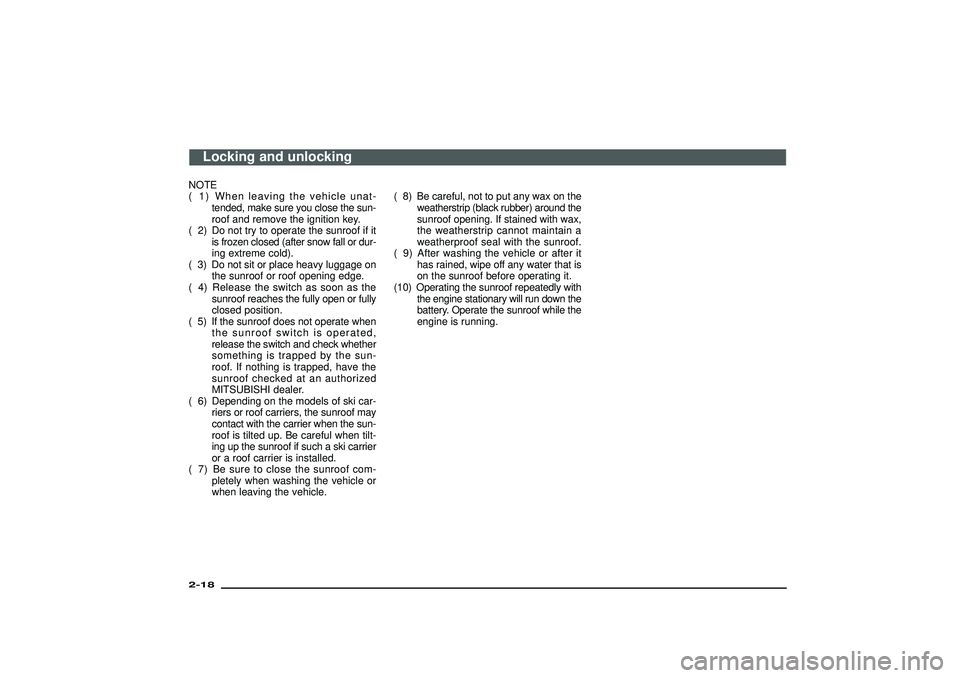
NOTE
( 1) When leaving the vehicle unat-
tended, make sure you close the sun-
roof and remove the ignition key.
( 2) Do not try to operate the sunroof if it
is frozen closed (after snow fall or dur-
ing extreme cold).
( 3) Do not sit or place heavy luggage on
the sunroof or roof opening edge.
( 4) Release the switch as soon as the
sunroof reaches the fully open or fully
closed position.
( 5) If the sunroof does not operate when
the sunroof switch is operated,
release the switch and check whether
something is trapped by the sun-
roof. If nothing is trapped, have the
sunroof checked at an authorized
MITSUBISHI dealer.
( 6) Depending on the models of ski car-
riers or roof carriers, the sunroof may
contact with the carrier when the sun-
roof is tilted up. Be careful when tilt-
ing up the sunroof if such a ski carrier
or a roof carrier is installed.
( 7) Be sure to close the sunroof com-
pletely when washing the vehicle or
when leaving the vehicle.( 8) Be careful, not to put any wax on the
weatherstrip (black rubber) around the
sunroof opening. If stained with wax,
the weatherstrip cannot maintain a
weatherproof seal with the sunroof.
( 9) After washing the vehicle or after it
has rained, wipe off any water that is
on the sunroof before operating it.
(10) Operating the sunroof repeatedly with
the engine stationary will run down the
battery. Operate the sunroof while the
engine is running.
Locking and unlocking
2-18Div:
Out put date:
Page 98 of 392
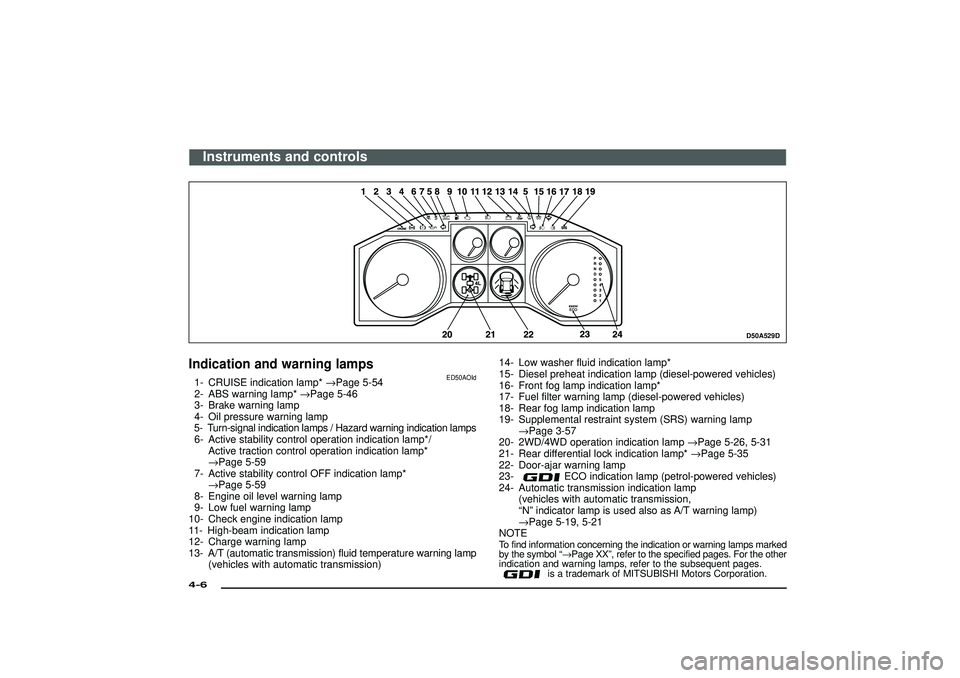
D50A529D
Indication and warning lamps
ED50AOId
1- CRUISE indication lamp*→Page 5-54
2- ABS warning lamp*→Page 5-46
3- Brake warning lamp
4- Oil pressure warning lamp
5- Turn-signal indication lamps / Hazard warning indication lamps
6- Active stability control operation indication lamp*/
Active traction control operation indication lamp*
→Page 5-59
7- Active stability control OFF indication lamp*
→Page 5-59
8- Engine oil level warning lamp
9- Low fuel warning lamp
10- Check engine indication lamp
11- High-beam indication lamp
12- Charge warning lamp
13- A/T (automatic transmission) fluid temperature warning lamp
(vehicles with automatic transmission)14- Low washer fluid indication lamp*
15- Diesel preheat indication lamp (diesel-powered vehicles)
16- Front fog lamp indication lamp*
17- Fuel filter warning lamp (diesel-powered vehicles)
18- Rear fog lamp indication lamp
19- Supplemental restraint system (SRS) warning lamp
→Page 3-57
20- 2WD/4WD operation indication lamp→Page 5-26, 5-31
21- Rear differential lock indication lamp*→Page 5-35
22- Door-ajar warning lamp
23-
ECO indication lamp (petrol-powered vehicles)
24- Automatic transmission indication lamp
(vehicles with automatic transmission,
“N”indicator lamp is used also as A/T warning lamp)
→Page 5-19, 5-21
NOTE
To find information concerning the indication or warning lamps marked
by the symbol“→Page XX”, refer to the specified pages. For the other
indication and warning lamps, refer to the subsequent pages.
is a trademark of MITSUBISHI Motors Corporation.
Instruments and controls
4-6Div:
Out put date:
Page 100 of 392
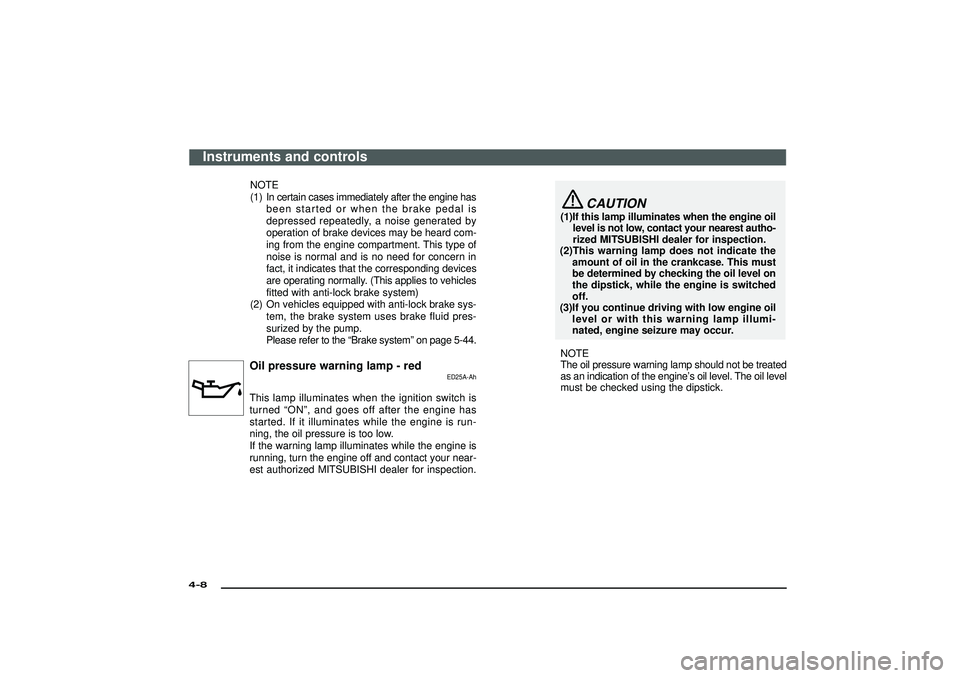
NOTE
(1) In certain cases immediately after the engine hasbeen started or when the brake pedal is
depressed repeatedly, a noise generated by
operation of brake devices may be heard com-
ing from the engine compartment. This type of
noise is normal and is no need for concern in
fact, it indicates that the corresponding devices
are operating normally. (This applies to vehicles
fitted with anti-lock brake system)
(2) On vehicles equipped with anti-lock brake sys-
tem, the brake system uses brake fluid pres-
surized by the pump.
Please refer to the “Brake system ”on page 5-44.Oil pressure warning lamp - red
ED25A-Ah
This lamp illuminates when the ignition switch is
turned “ON ”, and goes off after the engine has
started. If it illuminates while the engine is run-
ning, the oil pressure is too low.
If the warning lamp illuminates while the engine is
running, turn the engine off and contact your near-
est authorized MITSUBISHI dealer for inspection.
CAUTION
(1)If this lamp illuminates when the engine oil level is not low, contact your nearest autho-
rized MITSUBISHI dealer for inspection.
(2)This warning lamp does not indicate the amount of oil in the crankcase. This must
be determined by checking the oil level on
the dipstick, while the engine is switched
off.
(3)If you continue driving with low engine oil level or with this warning lamp illumi-
nated, engine seizure may occur.
NOTE
The oil pressure warning lamp should not be treated
as an indication of the engine ’s oil level. The oil level
must be checked using the dipstick.
Instruments and controls
4-8Div:
Out put date:
Page 102 of 392
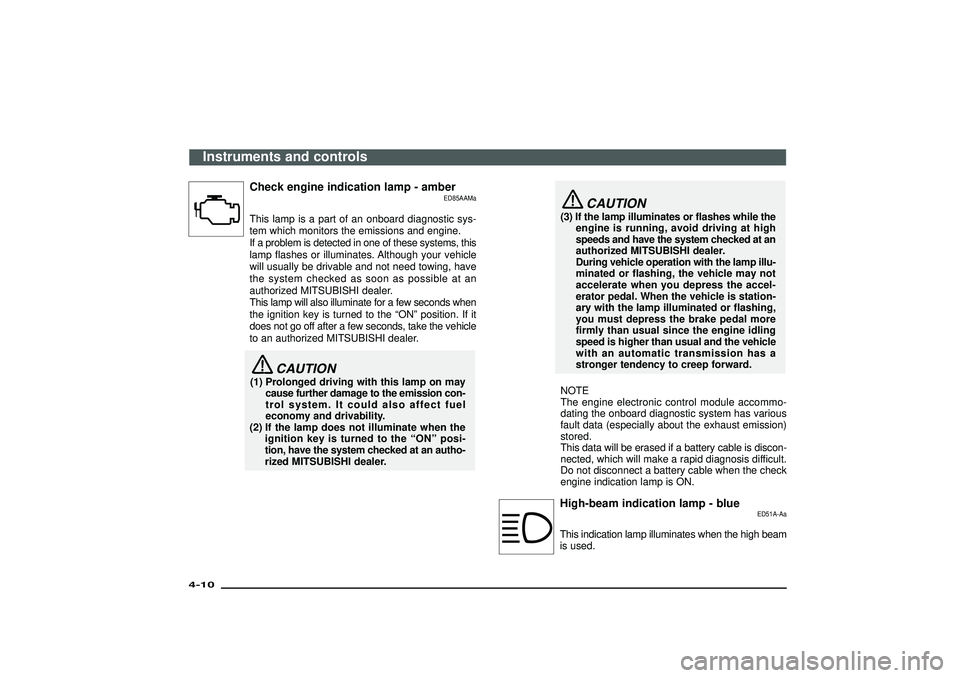
Check engine indication lamp - amber
ED85AAMa
This lamp is a part of an onboard diagnostic sys-
tem which monitors the emissions and engine.
If a problem is detected in one of these systems, this
lamp flashes or illuminates. Although your vehicle
will usually be drivable and not need towing, have
the system checked as soon as possible at an
authorized MITSUBISHI dealer.
This lamp will also illuminate for a few seconds when
the ignition key is turned to the “ON” position. If it
does not go off after a few seconds, take the vehicle
to an authorized MITSUBISHI dealer.
CAUTION
(1) Prolonged driving with this lamp on maycause further damage to the emission con-
trol system. It could also affect fuel
economy and drivability.
(2) If the lamp does not illuminate when the ignition key is turned to the “ON ”posi-
tion, have the system checked at an autho-
rized MITSUBISHI dealer.
CAUTION
(3) If the lamp illuminates or flashes while the engine is running, avoid driving at high
speeds and have the system checked at an
authorized MITSUBISHI dealer.
During vehicle operation with the lamp illu-
minated or flashing, the vehicle may not
accelerate when you depress the accel-
erator pedal. When the vehicle is station-
ary with the lamp illuminated or flashing,
you must depress the brake pedal more
firmly than usual since the engine idling
speed is higher than usual and the vehicle
with an automatic transmission has a
stronger tendency to creep forward.
NOTE
The engine electronic control module accommo-
dating the onboard diagnostic system has various
fault data (especially about the exhaust emission)
stored.
This data will be erased if a battery cable is discon-
nected, which will make a rapid diagnosis difficult.
Do not disconnect a battery cable when the check
engine indication lamp is ON.High-beam indication lamp - blue
ED51A-Aa
This indication lamp illuminates when the high beam
is used.
Instruments and controls
4-10Div:
Out put date:
Page 105 of 392
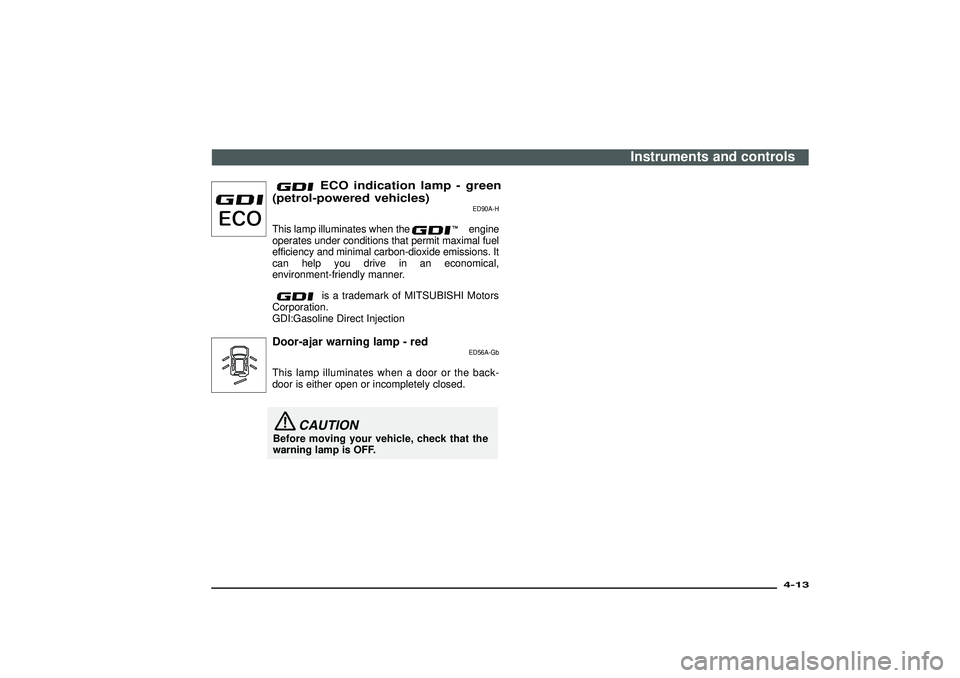
ECO indication lamp - green
(petrol-powered vehicles)
ED90A-H
This lamp illuminates when the
engine
operates under conditions that permit maximal fuel
efficiency and minimal carbon-dioxide emissions. It
can help you drive in an economical,
environment-friendly manner.
is a trademark of MITSUBISHI Motors
Corporation.
GDI:Gasoline Direct Injection
Door-ajar warning lamp - red
ED56A-Gb
This lamp illuminates when a door or the back-
door is either open or incompletely closed.
CAUTION
Before moving your vehicle, check that the
warning lamp is OFF.
Instruments and controls
4-13
Div:
Out put date:
Page 106 of 392
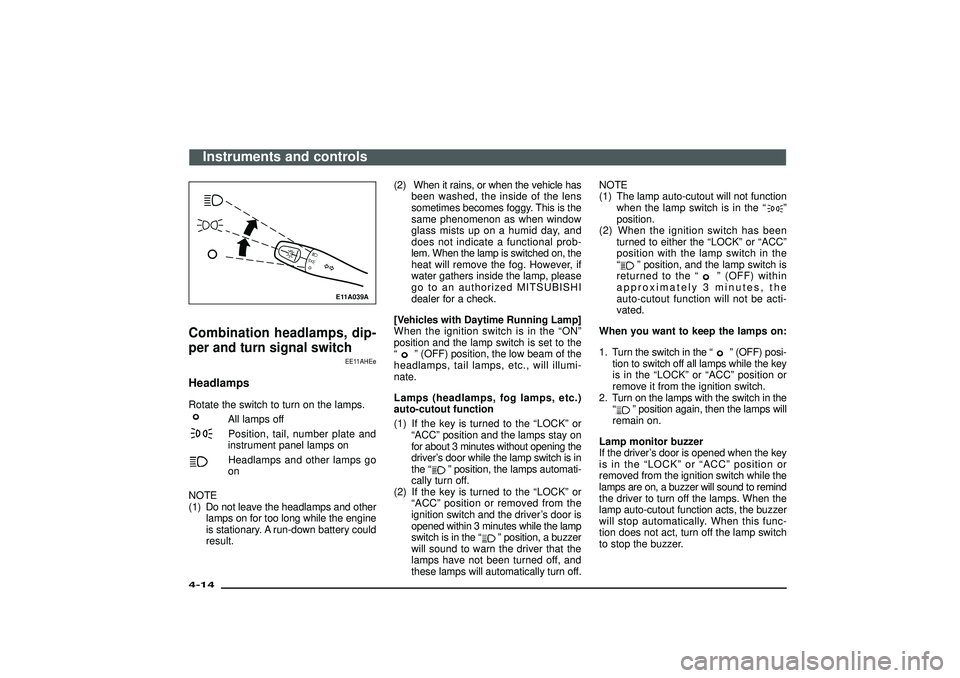
E11A039A
Combination headlamps, dip-
per and turn signal switch
EE11AHEe
HeadlampsRotate the switch to turn on the lamps.
All lamps offPosition, tail, number plate and
instrument panel lamps onHeadlamps and other lamps go
on
NOTE
(1) Do not leave the headlamps and other
lamps on for too long while the engine
is stationary. A run-down battery could
result.(2) When it rains, or when the vehicle has
been washed, the inside of the lens
sometimes becomes foggy. This is the
same phenomenon as when window
glass mists up on a humid day, and
does not indicate a functional prob-
lem. When the lamp is switched on, the
heat will remove the fog. However, if
water gathers inside the lamp, please
go to an authorized MITSUBISHI
dealer for a check.
[Vehicles with Daytime Running Lamp]
When the ignition switch is in the“ON”
position and the lamp switch is set to the
“
”(OFF) position, the low beam of the
headlamps, tail lamps, etc., will illumi-
nate.
Lamps (headlamps, fog lamps, etc.)
auto-cutout function
(1) If the key is turned to the“LOCK”or
“ACC”position and the lamps stay on
for about 3 minutes without opening the
driver’s door while the lamp switch is in
the“
”position, the lamps automati-
cally turn off.
(2) If the key is turned to the“LOCK”or
“ACC”position or removed from the
ignition switch and the driver’s door is
opened within 3 minutes while the lamp
switch is in the“
”position, a buzzer
will sound to warn the driver that the
lamps have not been turned off, and
these lamps will automatically turn off.NOTE
(1) The lamp auto-cutout will not function
when the lamp switch is in the“
”
position.
(2) When the ignition switch has been
turned to either the“LOCK”or“ACC”
position with the lamp switch in the
“
”position, and the lamp switch is
returned to the“
”(OFF) within
approximately 3 minutes, the
auto-cutout function will not be acti-
vated.
When you want to keep the lamps on:
1. Turn the switch in the“
”(OFF) posi-
tion to switch off all lamps while the key
is in the“LOCK”or“ACC”position or
remove it from the ignition switch.
2. Turn on the lamps with the switch in the
“
”position again, then the lamps will
remain on.
Lamp monitor buzzer
If the driver’s door is opened when the key
is in the“LOCK”or“ACC”position or
removed from the ignition switch while the
lamps are on, a buzzer will sound to remind
the driver to turn off the lamps. When the
lamp auto-cutout function acts, the buzzer
will stop automatically. When this func-
tion does not act, turn off the lamp switch
to stop the buzzer.
Instruments and controls
4-14Div:
Out put date:
Page 112 of 392
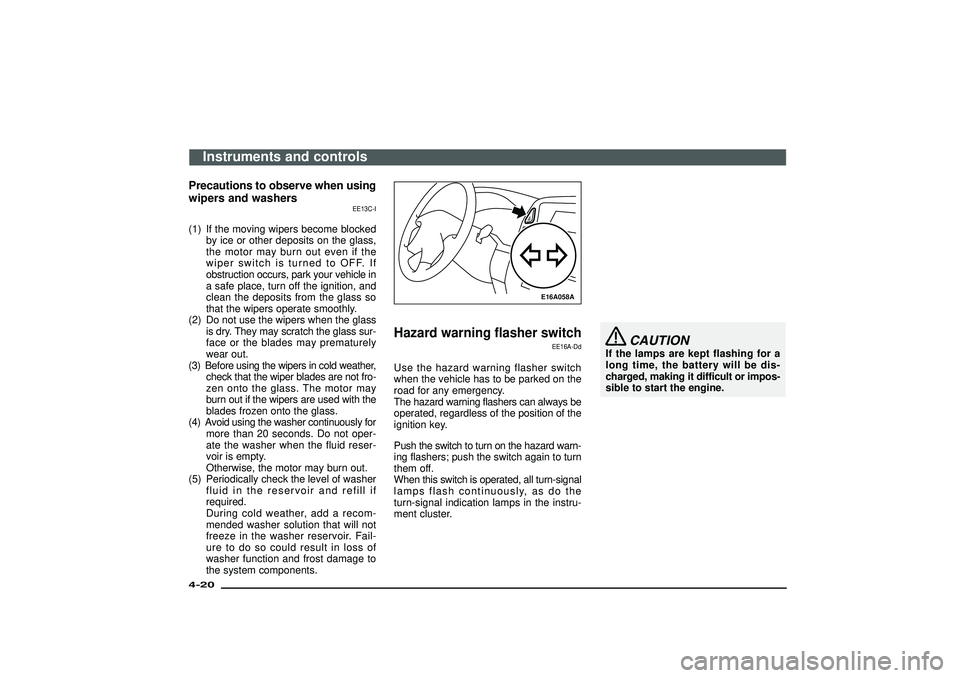
Precautions to observe when using
wipers and washers
EE13C-I
(1) If the moving wipers become blocked
by ice or other deposits on the glass,
the motor may burn out even if the
wiper switch is turned to OFF. If
obstruction occurs, park your vehicle in
a safe place, turn off the ignition, and
clean the deposits from the glass so
that the wipers operate smoothly.
(2) Do not use the wipers when the glass
is dry. They may scratch the glass sur-
face or the blades may prematurely
wear out.
(3) Before using the wipers in cold weather,
check that the wiper blades are not fro-
zen onto the glass. The motor may
burn out if the wipers are used with the
blades frozen onto the glass.
(4) Avoid using the washer continuously for
more than 20 seconds. Do not oper-
ate the washer when the fluid reser-
voir is empty.
Otherwise, the motor may burn out.
(5) Periodically check the level of washer
fluid in the reservoir and refill if
required.
During cold weather, add a recom-
mended washer solution that will not
freeze in the washer reservoir. Fail-
ure to do so could result in loss of
washer function and frost damage to
the system components.
E16A058A
Hazard warning flasher switch
EE16A-Dd
Use the hazard warning flasher switch
when the vehicle has to be parked on the
road for any emergency.
The hazard warning flashers can always be
operated, regardless of the position of the
ignition key.
Push the switch to turn on the hazard warn-
ing flashers; push the switch again to turn
them off.
When this switch is operated, all turn-signal
lamps flash continuously, as do the
turn-signal indication lamps in the instru-
ment cluster.
CAUTION
If the lamps are kept flashing for a
long time, the battery will be dis-
charged, making it difficult or impos-
sible to start the engine.
Instruments and controls
4-20Div:
Out put date:
Page 153 of 392
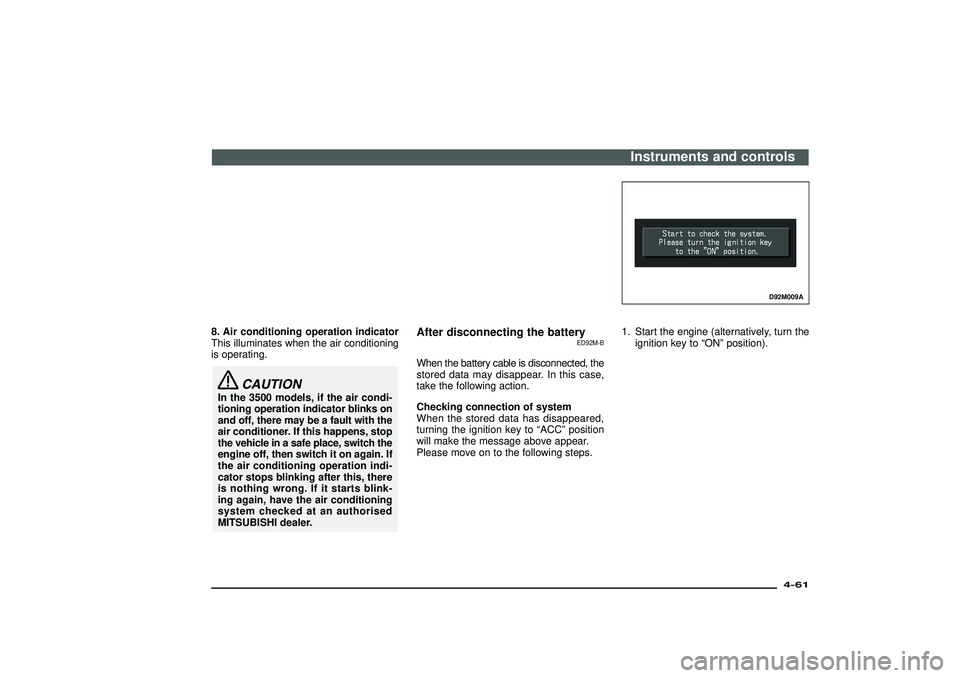
8. Air conditioning operation indicator
This illuminates when the air conditioning
is operating.
CAUTION
In the 3500 models, if the air condi-
tioning operation indicator blinks on
and off, there may be a fault with the
air conditioner. If this happens, stop
the vehicle in a safe place, switch the
engine off, then switch it on again. If
the air conditioning operation indi-
cator stops blinking after this, there
is nothing wrong. If it starts blink-
ing again, have the air conditioning
system checked at an authorised
MITSUBISHI dealer.
After disconnecting the battery
ED92M-B
When the battery cable is disconnected, the
stored data may disappear. In this case,
take the following action.
Checking connection of system
When the stored data has disappeared,
turning the ignition key to“ACC”position
will make the message above appear.
Please move on to the following steps.
D92M009A
1. Start the engine (alternatively, turn the
ignition key to“ON”position).Instruments and controls
4-61
Div:
Out put date:
Page 165 of 392
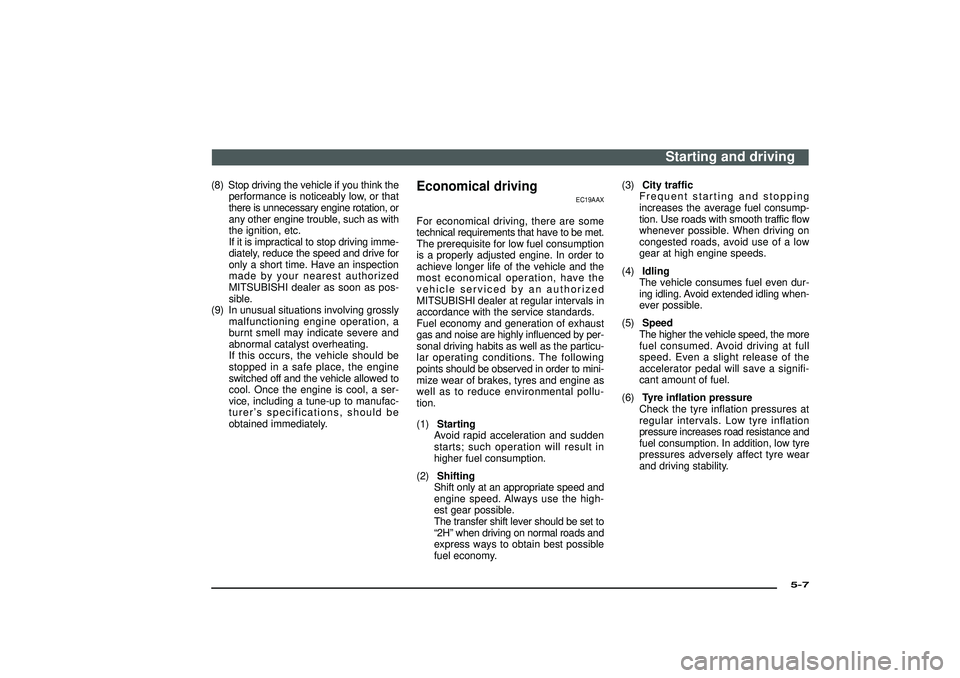
(8) Stop driving the vehicle if you think the
performance is noticeably low, or that
there is unnecessary engine rotation, or
any other engine trouble, such as with
the ignition, etc.
If it is impractical to stop driving imme-
diately, reduce the speed and drive for
only a short time. Have an inspection
made by your nearest authorized
MITSUBISHI dealer as soon as pos-
sible.
(9) In unusual situations involving grossly
malfunctioning engine operation, a
burnt smell may indicate severe and
abnormal catalyst overheating.
If this occurs, the vehicle should be
stopped in a safe place, the engine
switched off and the vehicle allowed to
cool. Once the engine is cool, a ser-
vice, including a tune-up to manufac-
turer’s specifications, should be
obtained immediately.
Economical driving
EC19AAX
For economical driving, there are some
technical requirements that have to be met.
The prerequisite for low fuel consumption
is a properly adjusted engine. In order to
achieve longer life of the vehicle and the
most economical operation, have the
vehicle serviced by an authorized
MITSUBISHI dealer at regular intervals in
accordance with the service standards.
Fuel economy and generation of exhaust
gas and noise are highly influenced by per-
sonal driving habits as well as the particu-
lar operating conditions. The following
points should be observed in order to mini-
mize wear of brakes, tyres and engine as
well as to reduce environmental pollu-
tion.
(1)Starting
Avoid rapid acceleration and sudden
starts; such operation will result in
higher fuel consumption.
(2)Shifting
Shift only at an appropriate speed and
engine speed. Always use the high-
est gear possible.
The transfer shift lever should be set to
“2H”when driving on normal roads and
express ways to obtain best possible
fuel economy.(3)City traffic
Frequent starting and stopping
increases the average fuel consump-
tion. Use roads with smooth traffic flow
whenever possible. When driving on
congested roads, avoid use of a low
gear at high engine speeds.
(4)Idling
The vehicle consumes fuel even dur-
ing idling. Avoid extended idling when-
ever possible.
(5)Speed
The higher the vehicle speed, the more
fuel consumed. Avoid driving at full
speed. Even a slight release of the
accelerator pedal will save a signifi-
cant amount of fuel.
(6)Tyre inflation pressure
Check the tyre inflation pressures at
regular intervals. Low tyre inflation
pressure increases road resistance and
fuel consumption. In addition, low tyre
pressures adversely affect tyre wear
and driving stability.
Starting and driving
5-7
Div:
Out put date:
Page 172 of 392
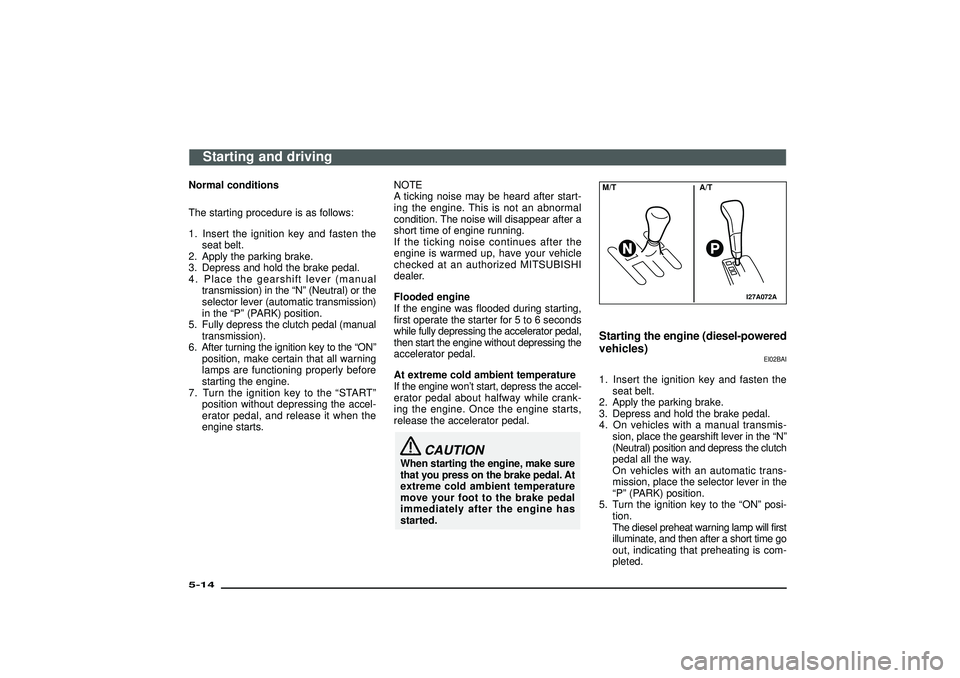
Normal conditions
The starting procedure is as follows:
1. Insert the ignition key and fasten the
seat belt.
2. Apply the parking brake.
3. Depress and hold the brake pedal.
4. Place the gearshift lever (manual
transmission) in the“N”(Neutral) or the
selector lever (automatic transmission)
in the“P”(PARK) position.
5. Fully depress the clutch pedal (manual
transmission).
6. After turning the ignition key to the“ON”
position, make certain that all warning
lamps are functioning properly before
starting the engine.
7. Turn the ignition key to the“START”
position without depressing the accel-
erator pedal, and release it when the
engine starts.NOTE
A ticking noise may be heard after start-
ing the engine. This is not an abnormal
condition. The noise will disappear after a
short time of engine running.
If the ticking noise continues after the
engine is warmed up, have your vehicle
checked at an authorized MITSUBISHI
dealer.
Flooded engine
If the engine was flooded during starting,
first operate the starter for 5 to 6 seconds
while fully depressing the accelerator pedal,
then start the engine without depressing the
accelerator pedal.
At extreme cold ambient temperature
If the engine won’t start, depress the accel-
erator pedal about halfway while crank-
ing the engine. Once the engine starts,
release the accelerator pedal.
CAUTION
When starting the engine, make sure
that you press on the brake pedal. At
extreme cold ambient temperature
move your foot to the brake pedal
immediately after the engine has
started.
I27A072A
M/T A/TStarting the engine (diesel-powered
vehicles)
EI02BAI
1. Insert the ignition key and fasten the
seat belt.
2. Apply the parking brake.
3. Depress and hold the brake pedal.
4. On vehicles with a manual transmis-
sion, place the gearshift lever in the“N”
(Neutral) position and depress the clutch
pedal all the way.
On vehicles with an automatic trans-
mission, place the selector lever in the
“P”(PARK) position.
5. Turn the ignition key to the“ON”posi-
tion.
The diesel preheat warning lamp will first
illuminate, and then after a short time go
out, indicating that preheating is com-
pleted.
Starting and driving
5-14Div:
Out put date: